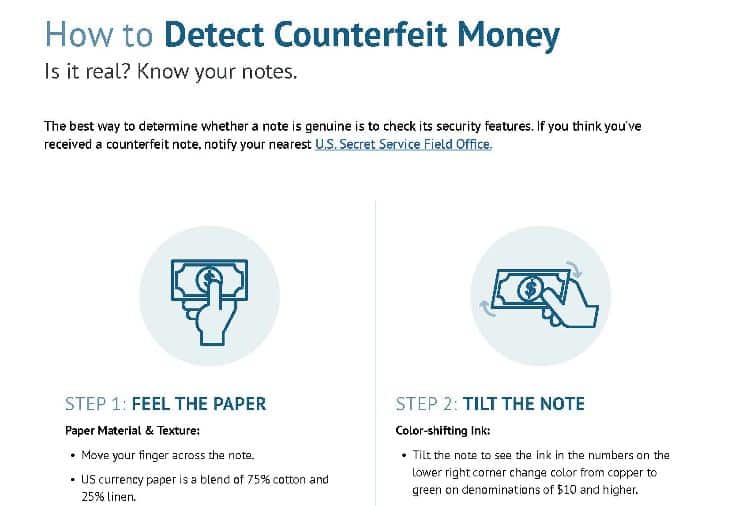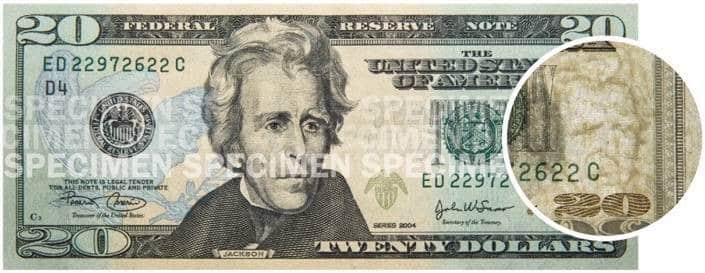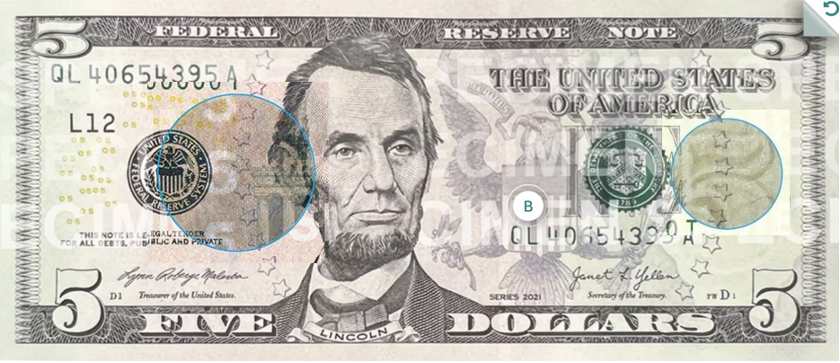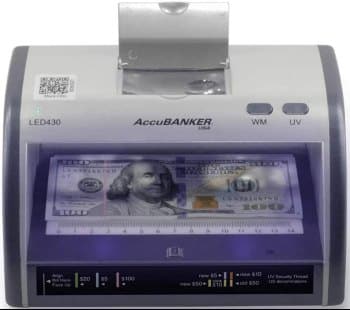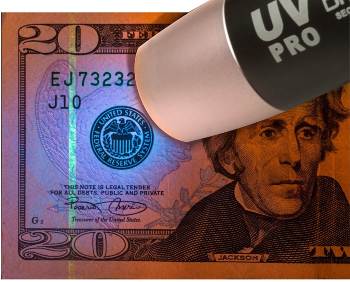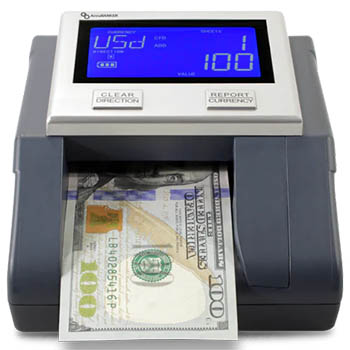Counterfeit money is currency produced by someone other than the government intended to deceive the recipient into believing it is authentic. Learning how to detect counterfeit money is a crucial part of store management. In 2022 alone, the Secret Service seized over $41.5 million in counterfeit currency.
Key takeaways:
- To check for bill authenticity, feel the paper, tilt the note, and check with light and magnification.
- Train your employees well and let them know a fake $20 bill is the most common counterfeit note they will see.
- Small businesses can also invest in tools such as UV lights, counterfeit detector pens, and magnifying glasses to help make counterfeit detection easier.
We go through the details below, but first, download our counterfeit money checklist to serve as a guide.
8 Security Features to Detect Counterfeit Money
The Bureau of Engraving and Printing designs and produces Federal Reserve Notes to include a number of security features. Counterfeiters can sometimes duplicate one or two of these unique characteristics but rarely all of them.
Note: Most of the examples we use in our guide are of a $20 bill because it is the most counterfeited denomination of currency in the US. However, some security features vary by denomination. Likewise, security features have improved over time as currency is redesigned, so old bills may be more difficult to evaluate.
1. Watermark
Watermarks in currencies are a characteristic security feature of authentic banknotes.
When confirming the authenticity of a watermark, make sure it is:
- Only visible when you hold it up to the light
- Located to the left of the portrait and on the right edge on $5 bills
- Located to the right of the portrait on $10, $20, $50, and $100 bills
- Visible from both sides of the bill
- A replica of the portrait on the bill in the case of $10, $20, $50, and $100 notes
Generally speaking, if there is no watermark or the watermark is visible without being held up to the light, the bill is likely a counterfeit.
When evaluating the most recent $5 bill design, hold the note up to the light to see three numeral 5s to the left of the portrait and on the right edge; in the previous design, the watermark depicts Lincoln’s portrait.
On new $10, $20, $50, and $100 notes, the watermark is a replica of the portrait and is located to the right of the printed image.
2. Color-shifting Ink
Look for color-shifting ink on the numbers (denomination) in the lower right corner of a $10, $20, $50, or $100 bill.
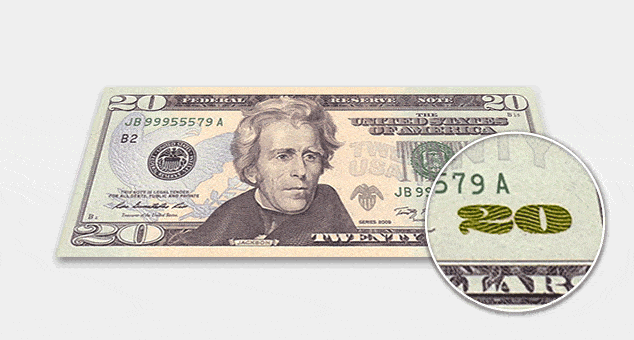
Animation of color-shifting ink transitioning from copper to green on the $20 bill
(Source: Federal Reserve Bank Atlanta)
In addition to the color-shifting denomination, the 2013-style $100 bills feature a color-shifting bell in the inkwell. While the inkwell remains a copper color, the bell shifts from copper to green when viewed from a different angle.
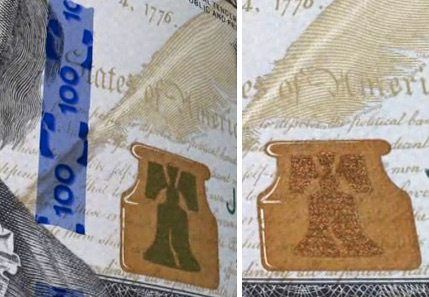
The bell in the inkwell appears copper when viewed straight-on (right) and shifts to green when tilted (left).
3. Security Thread
The security thread is one of the most distinctive security indicators of an authentic bill. If you hold a genuine bill with a denomination of $5 or more up to the light, you will see a security thread running vertically across the bill to the right or left of the portrait.
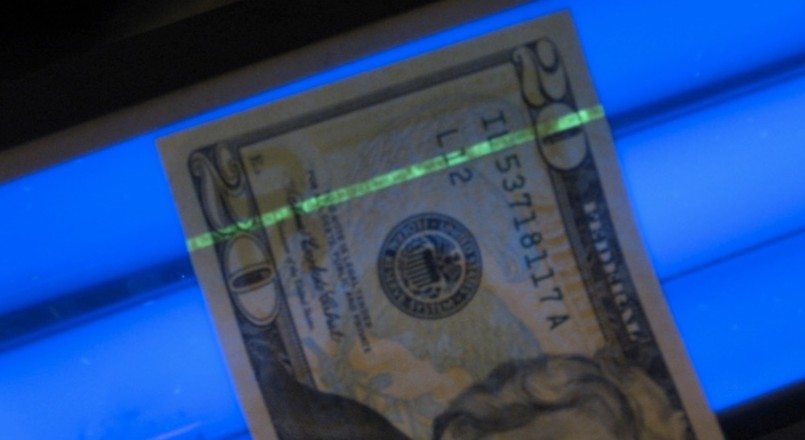
Image of the security thread in a $20 bill as seen under a UV light. (Source: Wikipedia)
That said, the ultimate test involves viewing the bill under an ultraviolet (UV) light to confirm the security thread glows the correct color. This extra security measure was originally added to provide a quick way for bartenders to check the legitimacy of a bill. Based on these features, fake bills will either lack a security thread entirely or have a security thread with text, location, and/or color that do not match the denomination.
On $5, $10, and $50 bills, the thread is located to the right of the portrait; on $20 and $100 bills it is located to the left of the portrait. The threads are imprinted with “USA” and the denomination alternating across the bill, although the exact format of this text varies by denomination—as detailed in the table below.
Security Thread Features for Each Denomination
Denomination | Location of Security Thread* | Text Imprinted on Thread | Color Under UV Light |
|---|---|---|---|
$5 | Right of the portrait | USA 5 | Blue |
$10 | Right of the portrait | USA TEN and a small flag | Orange |
$20 | Left of the portrait | USA TWENTY and a small flag | Green |
$50 | Right of the portrait | USA 50 and a small flag | Yellow |
$100 | Left of the portrait | USA 100 | Pink |
*Federal Reserve notes designed before 1990 do not contain security threads. | |||
4. Security Ribbon
Unlike other notes, the most recent $100 note design has a 3-D security ribbon woven into the paper to the right of Benjamin Franklin’s portrait. By moving the bill, you can see images of bells and 100s shift as you move. Tilting the note back and forth makes the bells and 100s move side to side; tilting the bill side to side causes them to move up and down. This 3-D security ribbon reportedly cannot be duplicated by counterfeiters, making it an easy way to confirm the authenticity of a $100 bill.
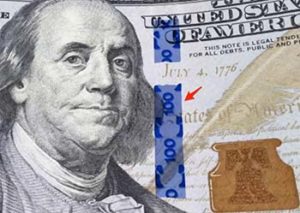
Blue security ribbon on the $100 bill
5. Crisp Printing & Borders
Authentic US currency is printed using extremely detailed, die-cut printing plates capable of creating impressively fine lines. Because of that, counterfeit printers are rarely capable of duplicating the level of detail.
To spot a counterfeit bill, take a close look at the printing quality—especially the borders—to see if there are any blurred areas. If you notice significantly blurry borders, printing, or text, it’s an automatic red flag for counterfeit money.
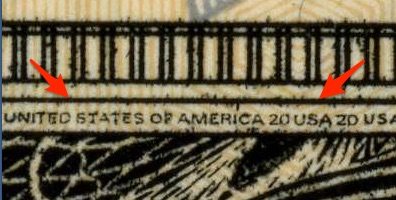
Blurry printing on a fake $20 bill
6. Microprinting
Genuine US currency of $5 denominations and greater is characterized by microprinting. This super-fine text is difficult for counterfeiters to reproduce with their less advanced equipment. For that reason, counterfeited bills may exhibit unreadable microprinting when viewed under magnification.
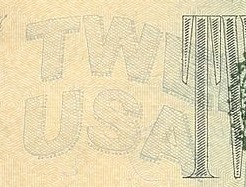
Close-up of “USA 20” microprinting to the right of the portrait on a $20 bill
(Source: Wikipedia)
The location—and text—of microprinting on US currency varies by denomination, so look out for these features when checking the most recent version of each note for authenticity.
Denomination-specific Microprinting
Bill | Microprinting |
|---|---|
$5 |
|
$10 |
|
$20 |
|
$50 |
|
$100 |
|
*Federal Reserve notes designed before 1990 do not feature microprinting. | |
7. Paper Material & Texture
The paper used by the Federal Reserve for US currency is made up of 25% linen and 75% cotton; it has been supplied to the US Bureau of Engraving and Printing by Crane and Co. since 1879. In addition to their composition, authentic bills feature small red and blue security fibers evenly distributed throughout the material of the bill.
Counterfeiters attempt to reproduce this effect by printing red and blue threads onto fake bills in a similar pattern. But, a close look often reveals that the “fibers” are merely on the surface level—and indicates you have a fake bill on your hands. All Federal Reserve notes are printed on paper with embedded security fibers.
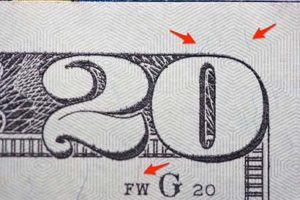
Close-up of red and blue security fibers embedded in $20 bill
Notes have a unique texture due to the raised printing used on notes of every denomination—including $1 and $2 notes. Larger denominations feature enhanced intaglio printing on the portraits.
By running your fingers across portions of the bill, you’ll be able to feel this raised texture that’s not present in most counterfeit currency. The best place to check is along the shoulders of the people on the bills; you should be able to feel bumps and ridges.
8. Serial Number & Series Year
A final check when evaluating the authenticity of a bill is to compare the serial number and the series year printed on the front of the note. The serial number, which includes a unique combination of 11 numbers and letters, appears twice on the front of each note—on the right side and in the upper left corner. On an authentic bill, the first letter of the serial number corresponds to the series year printed to the right of the portrait.
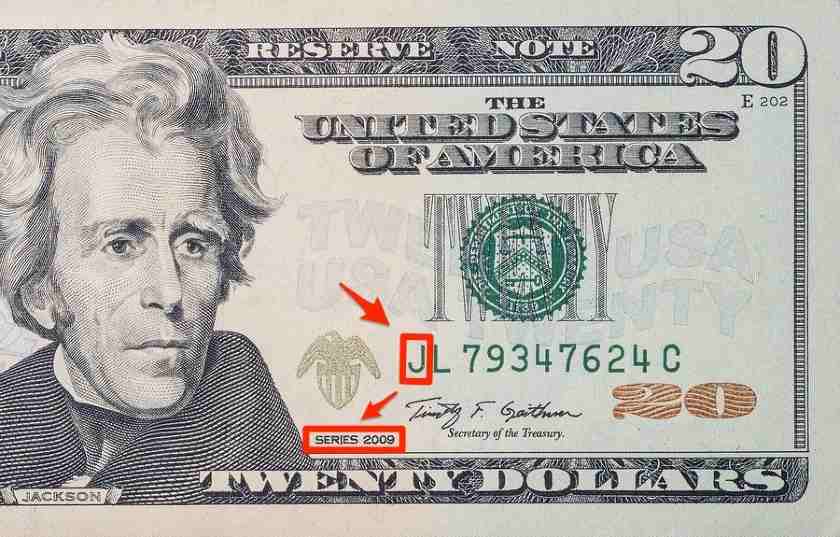
Serial number and series year notated on $20 bill
Serial Years With Corresponding Serial Letters
Year | Series Letter | Year | Series Letter |
|---|---|---|---|
1996 | A | 2006 | I |
1999 | B | 2009 | J |
2001 | C | 2006A | K |
2003 | D | 2009A | L |
2004 | E | 2013 | M |
2003A | F | 2017 | N |
2004A | G | 2017A | P |
2006 | H | 2021 | Q |
The series year indicates the year in which a new design was approved by the Secretary of the Treasury. It also indicates when the signature of a new secretary or treasurer was incorporated into the design. Capital letters following the series year appear when there is a significant change in the currency note’s appearance.
Quick Guide to Spot Fake Bills
Different bills have different security features to help you spot fake money. We picked some key features for each denomination that are quick to check and put them together in a guide for spotting fake $5, $10, $20, $50, and $100 bills.
Keep in mind that these are not the only features to look for, but if any of the features in the table below is missing from a bill you are checking, it is likely counterfeit.
Bill | Watermark | Security Thread | Microprinting | Other Features |
|---|---|---|---|---|
$5 | Numeral 5s on the left of the portrait; Numeral 5 on the right | Blue (on the right of the portrait) | 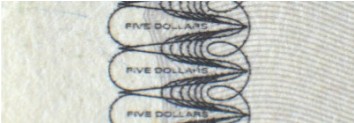 “FIVE DOLLARS” repeated inside the borders of the note | N/A |
$10 | Alexander Hamilton portrait on the right | Orange (on the right of the portrait) | 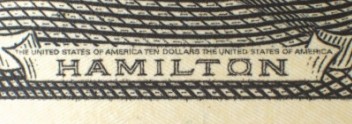 “THE UNITED STATES OF AMERICA” and “TEN DOLLARS USA” printed below the portrait | N/A |
$20 | Andrew Jackson portrait on the right | Green (on the left of the portrait) | 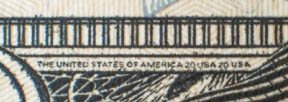 “THE UNITED STATES OF AMERICA 20 USA 20” printed in black in the border below the Treasurer’s signature | N/A |
$50 | Ulysses S. Grant portrait on the right | Yellow (on the right of the portrait) | 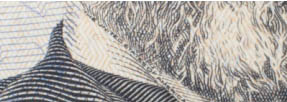 “THE UNITED STATES OF AMERICA” printed in President Grant’s collar | N/A |
$100 | Benjamin Franklin portrait on the right | Pink (on the left of the portrait) | 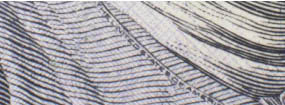 “THE UNITED STATES OF AMERICA” printed on Benjamin Franklin’s collar | 3-D security ribbon and color-shifting bell on the inkwell |
Tools to Detect Counterfeit Money
Just as it’s important to prevent chargebacks in a credit card-driven business, business owners and employees should know how to distinguish between authentic and fake currency during cash transactions. To simplify the process—and improve accuracy—there are a variety of products available.
Examples of Counterfeit Money Detectors
Tool | What Security Feature It Checks | How It Works |
|---|---|---|
UV Lights | Security threads, watermarks, hidden markings | Shows currency notes’ security threads, ribbons, and watermarks. |
UV Light Systems | Security threads, watermarks | It has UV light indicators in its base to show where security threads should be. You can check if the security thread lines up correctly and glows the correct color by placing bill on the base. |
Currency Counters/Detectors | Security threads, magnetic ink | Most counters employ the use of UV, magnetic, and/or infrared technology. |
Counterfeit Detector Pens | Correct paper | Pens contain iodine-based inks that react with starches contained in wood. When reacting with counterfeits, the ink turns dark. For authentic notes, the ink remains clear or slightly yellow. |
UV Light / Counterfeit Pens | Correct paper, security threads, watermarks | Pens like these have ink and UV light (both ends) to test for more security features. |
Magnifying Glasses | Printing errors, microprinting | These help make it easier to read serial numbers and notice printing errors in counterfeits, such as the absence of microprinting. |
Best Counterfeit Money Detectors
If you’re intimidated by the threat of counterfeits and want to reduce the risk of losing profits due to fraud, consider using a merchant account to cut down on cash transactions and improve the security of credit card payments.
What to Do if You Detect a Counterfeit Bill
If you suspect you’ve been given a counterfeit bill, follow the recommended steps below to protect yourself and ensure that the US Secret Service can evaluate the fake currency.
Losing profits to larceny can hurt profits as much as reduced sales. Learn more about reducing retail theft.
1. Avoid putting yourself in danger. If you think a bill is counterfeit, do not make any statements or take any actions that might cause the passer to threaten or harm you.
2. Do not return the bill to the customer. Keep the bill so that you can pass it along to law enforcement. You won’t receive any financial remuneration for surrendering a counterfeit bill to law enforcement, but doing so can help combat counterfeiting.
3. Jot down some notes about the passer. Observe and record as much about the passer and their companions as possible—characteristics like height, weight, eye color, hair color, and any other unique features. Where possible, write down the passer’s license plate number and other identifying information.
4. Contact local law enforcement or the local US Secret Service Office. As soon as you suspect that a bill is counterfeit—and you’re not at risk—contact local law enforcement. Once you’ve made contact, only surrender the note to an identified police office or Secret Service Special Agent; you may also be directed to mail it to the nearest Secret Service field office.
The US Secret Service’s Counterfeit Currency Processing Facility (CCPF) accepts and processes suspected counterfeit currency submissions from businesses and financial institutions in all 50 states. You can also choose to report counterfeit currency through its website.
5. Write your initials and the date on the border of the bill. Before passing a suspected counterfeit bill to law enforcement, write your initials and the date in the white border area of the note.
6. Handle the bill as little as possible. In some cases, there may be remnants of fingerprints, DNA, or certain processing chemicals that can help the police tie a bill to a certain counterfeiter. Handle a potential counterfeit as little as possible and separate the bill from your other cash by putting it in a protective cover, plastic bag, or marked envelope until you can submit it to the Secret Service.
Counterfeit Money Frequently Asked Questions (FAQs)
Authentic US banknotes have characteristic security features—watermark, security thread, and color-shifting ink, to name a few. Fake bills can have one or two of these unique characteristics but rarely all of them. Familiarize yourself with each bill’s security features. Generally, to check for fake dollar bills, it is advised to feel the paper, tilt the note, and check with light and with magnification.
If you are using counterfeit pens to check the authenticity of banknotes, fake bills will turn the ink black or dark blue. Genuine bills will turn the ink yellow. Note, though, that counterfeit pens are not as accurate on more advanced fake money. However, they still can help identify some fake bills.
Yes, it may feel similar to authentic bills. However, one sign of counterfeit money is that it feels smooth. Run your fingers over the shoulders of the portraits. Real money has bumps and ridges.
If you realize it’s fake, immediately contact the police. Follow the steps listed above as they apply to your situation. It should go without saying that you should not try to use it. If, however, you are caught accidentally trying to use counterfeit money, then work with the store owner to contact the police. Try to remember where you got the bill and (of course) pay for your purchase with legitimate bills. If you are charged with using counterfeit currency, contact your attorney.
The most common mistakes are errors in color or paper and poor printing. The easiest way is to check for color-shifting ink and to feel for the texture of the paper.
First, the bills are worthless; the government will not honor them even if you turn them in. Second, it’s a felony to pass counterfeit bills. It also hurts the economy and can contribute to inflation, which means higher prices for the things you want.
Bogus bills are more often passed along at retail stores. Banks usually have more safeguards to detect counterfeit money, so it’s less likely you’ll find them from an ATM.
Bottom Line
Whether you are just starting a retail business or managing your existing store, learning to identify fake money and training your employees to do the same is important. Start by introducing your staff to each of the security features incorporated into authentic US currency—of each denomination. Then, consider investing in tools like UV lights or all-in-one counterfeit detectors if you want to provide an extra line of defense for your business. Retail employees who know how to spot fake bills can help reduce losses to counterfeit money.
If your business continues to struggle with counterfeit money, consider reducing your dependency on cash transactions. Get started by learning more about the easiest ways to accept credit card payments.

